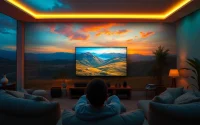Captivating 3D Model Visualizations: Techniques and Tools for Stunning Results
Understanding 3D Model Visualizations
What Are 3D Model Visualizations?
3D model visualizations refer to the process of creating interactive and realistic representations of objects, environments, or data through computer-generated imagery. This process allows designers, architects, marketers, and various industries to showcase their ideas and products effectively. The ability to view models from multiple angles and zoom in on details enhances understanding and engagement, making it a vital tool in today’s digital-centric world. For more on this topic, explore 3D Model Visualizations.
The Importance of 3D Visualizations in Design
The significance of 3D visualizations in design cannot be overstated. They bridge the gap between conceptual ideas and tangible products, enabling stakeholders to visualize the end results before committing to production. Architects utilize these visualizations to communicate their visions to clients, helping to refine designs through feedback and modifications. In marketing, businesses use 3D models for advertising, creating realistic product images that can enhance consumer engagement and ultimately drive sales. Moreover, visualizations facilitate collaboration among teams, reducing misunderstandings that often occur with 2D drawings and descriptions.
Key Tools for 3D Model Visualizations
A plethora of tools is available for creating 3D model visualizations, each offering unique features and capabilities. Some of the most popular programs include:
- Autodesk Maya: Known for its powerful modeling and rendering tools, making it a favorite in film and game design.
- Blender: An open-source software that allows for modeling, sculpting, and animation with an extensive community backing.
- SketchUp: Ideal for architectural visualization due to its user-friendly interface and quick modeling capabilities.
- Unity: Primarily a game engine, but also widely used for creating interactive visualizations and AR/VR applications.
The Process of Creating 3D Model Visualizations
Step-by-Step Guide to Building Models
Creating a 3D model visualization often involves several key steps:
- Concept Development: Start with sketches or rough ideas to define what you want to visualize.
- Modeling: Use software to create a 3D object, integrating dimensions and various geometrical shapes.
- Texturing: Apply textures to add realism, enhancing the detail and appearance of surfaces.
- Lighting: Properly set up lights to create mood and depth, influencing the perception of the model.
- Rendering: Produce a final image or animation, selecting appropriate quality settings for your target medium.
- Feedback and Iteration: Present the model to peers or clients, gather feedback, and make necessary adjustments.
Best Practices for Accurate Visualizations
To ensure that your 3D visualizations are accurate and effective, consider the following best practices:
- Choose the right scale and measurements to reflect reality.
- Utilize high-quality textures and materials to enhance realism.
- Incorporate real-world lighting conditions for authenticity.
- Regularly review your work with peers or clients to maintain alignment with their expectations.
- Stay updated with new software updates and techniques to continually improve your skills and workflows.
Common Challenges and How to Overcome Them
Despite its advantages, creating 3D model visualizations can come with its challenges:
- Software Complexity: Many tools have steep learning curves. Overcome this by investing time in tutorials and practice.
- Technical Issues: Rendering errors or crashes can hinder progress. Ensure your hardware meets software requirements and save frequently.
- Client Communication: Misunderstandings can arise from technical jargon. Use simple language and visual aids to clarify concepts.
Advanced Techniques in 3D Model Visualizations
Using Lighting and Shadows Effectively
Lighting is a crucial aspect of any 3D visualization, as it significantly affects the mood and realism of a project. Experiment with various lighting setups, such as three-point lighting, to enhance depth. Make sure to consider the source of light—whether natural or artificial—and study how it interacts with materials. Be mindful of shadows; they add drama and clarity, helping viewers focus on the important elements of your model.
Integrating Textures and Materials
Textures and materials add authenticity to 3D models. Utilize high-resolution images and realistic material properties to enhance your work. It’s essential to apply proper UV mapping techniques to ensure that textures align correctly on the surfaces of your models. Experiment with PBR (Physically Based Rendering) principles to simulate how materials react to light, which can dramatically increase realism.
Incorporating Animation into Visualizations
Adding animation to 3D visualizations can elevate them from static images to engaging narratives. This can be particularly effective in presentations and marketing. Consider using animation to demonstrate functionality or to guide viewers through a story. Ensure that movements are smooth and deliberate; use keyframe animations and consider physics simulations for more dynamic results.
Real-World Applications of 3D Model Visualizations
Architecture and Interior Design
3D model visualizations have revolutionized architecture and interior design. Architects use them to create lifelike representations of buildings, allowing clients to visualize spaces before construction begins. Through virtual walkthroughs, clients can examine layouts, materials, and lighting, leading to better decision-making and satisfaction with the design process.
Virtual Reality and Augmented Reality Projects
The application of 3D visualizations in virtual reality (VR) and augmented reality (AR) has opened new frontiers. These technologies allow users to immerse themselves in fully interactive environments. For instance, real estate developers can showcase properties to potential buyers through VR, enhancing the marketing experience and increasing sales potential. In industrial settings, AR can overlay informative visuals on physical objects, aiding in training and maintenance procedures.
Product Design and Marketing Strategies
In product design, 3D model visualizations are invaluable for prototyping and marketing. Companies can create hyper-realistic images of products that are still in the concept phase, enabling pre-launch marketing campaigns. This ensures better customer engagement and more precise feedback before actual production begins, thus reducing costs and time in the development process.
Measuring the Impact of 3D Model Visualizations
Key Performance Indicators for Success
To gauge the effectiveness of your 3D visualizations, consider tracking the following key performance indicators:
- Engagement Metrics: Monitor how users interact with visual content, including views, clicks, and time spent on visualizations.
- Client Feedback: Collect qualitative data from clients regarding their understanding and reactions to the visualizations.
- Sales Conversions: Assess the impact of visualizations on sales figures, particularly for marketing campaigns.
Case Studies: Successful 3D Visualization Projects
Success in 3D model visualization is often illustrated through compelling case studies:
- Architectural Firms: Many firms have successfully integrated 3D visualizations into their workflows, leading to significantly shortened project timelines and increased client satisfaction.
- Product Launches: Companies that employed 3D renderings for their product launches often reported a positive uptick in audience engagement and pre-orders based on the visualizations alone.
Future Trends in 3D Model Visualizations
The future of 3D model visualizations is bright and continuously evolving. Keeping an eye on emerging trends can provide insights into what lies ahead:
- Artificial Intelligence: AI-driven tools can assist in automating modeling processes and improving accuracy through machine learning.
- Real-time Rendering: The push toward real-time rendering capabilities will enhance interactive experiences, allowing instant feedback and editing.
- Cloud-based Collaboration: More companies are integrating cloud solutions for seamless collaboration among teams and clients, enabling easier sharing and access to 3D models.


